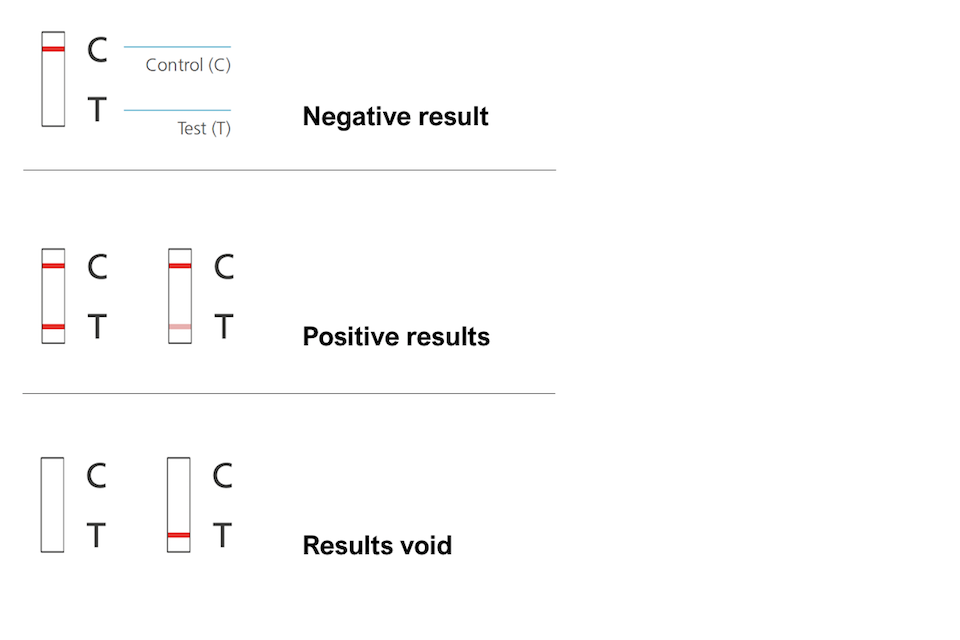Two weeks after receiving the first dose of the vaccine for Sars-CoV-2 (the name of the virus causing COVID-19), I tested positive for the virus. This was probably not because of the vaccine but because I was infected with the virus. Remember, vaccines are not 100% effective, and they can take about 4 weeks to begin to have an effect in most cases. Instead of only sending off a sample to a lab which can take a few days, in my workplace, we use a lateral flow test, which gives a quick result (within 30 minutes). Here we will go through the test and how it works.
A lateral flow test just means the sample being tested, flows along a cartridge in one direction. The sample then passes across some antibodies and chemicals that, if the sample contains the bit you’re testing for, it will stick to the antibodies and the chemicals react, giving a colour change (as a band you can see on the device). We do this test at the beginning of each day at work, because someone might be infected without knowing and pass the virus on to other people who are more vulnerable to getting very sick.
Follow through to learn how to use this test, how it works and test how well you have learned with some questions at the end!
How to use the kit?

- It is really important to wash your hands properly and ideally use gloves when performing the test, because several staff share the kit and we do not want to contaminate anything.
- Prepare everything required. (picture)
- Insert a few drops of a special buffer solution (A) into a tube (B).
- Unpackage the swab (C) and swab your tonsils and nostrils for 10 seconds each. This is not pleasant!
- Push the swab (C) into the tube with buffer solution (A+B) and squeeze out any liquid that has soaked into the swab by pressing on the tube.
- Put the lid (D) onto the tube.
- Put 2 drops onto the cartridge sample spot and wait for results by looking for lines! This takes around 30 minutes.
- Dispose of everything safely into a bin without contaminating any surfaces.


How does a lateral flow test work?
When you swab your nose and tonsils, you are trying to collect the virus onto your swab. The special buffer solution (A in photo) breaks the virus apart into smaller pieces, known as antigens.
Antigens are the informaton that your body’s cells use to determine if something is from your body or an alien invading your body. In this case, the antigen is a small protein that is part of the virus. The antigens on your cells are different to antigens from the virus which lets your body know there is an intruder!
When you place a few drops on the test kit, how does the liquid flow up the test kit if nothing is moving it? This is because of a special property of water called capillary action which causes water to flow without assistance. You can look at this yourself by doing the following experiment:

Water flows along the tissue into the other cup by itself! This is what is happening in the test kit, but it is carrying things with it as it flows.
After your sample is added (see step 1 below), it flows to antibodies that stick to the antigen (step 2). These antibodies are very specific to the antigen from the virus which stops it attaching to something random. Antibodies are your body’s special weapon when fighting infections because it sticks to them and stops them from damaging your body.
In step 3, there are a line of different antibodies that are different but also specific to the virus antigen. This sticks to the virus that is also stuck to the purple antibody from step 2. This means there is a fixed purple line on the test kit. But this only happens if the sample contained the virus.
Not all antibodies from step 2 bind to the virus. If there was no virus in the sample, all the antibodies will flow with the sample past the T line until they reach the C line in step 4. The C line has another different set of antibodies which is specific to and sticks to the antibody from step 2. It does not attach to the virus or anything else. This makes another strong fixed purple line at the C line. This tells you the test worked and everything has flowed from one end to the other.

Test yourself!
- What is an advantage of the lateral flow test compared to sending a test to the lab?
- When you swab your nose and throat, what are you collecting?
- What attaches to antigens in your body and in the test? (CLUE: A _ _ _ – B _ _ _ _ _)
- How many lines appear if you test positive for the virus?
- What would you see if you did the test but did not have the virus?
- Stretch Question: What would it mean if you saw a line at T but no line at C?
Let us know how well you did by tweeting @ShowMeTheSci! Thanks for reading 🙂
